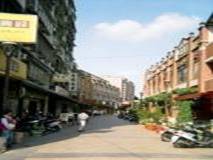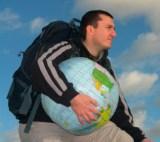Though of no great size, the town of Yingge (pop. 84,000) is about thirty minutes by train and a couple of hours by bus south-southwest of the capital. After visiting it twice and staying the night both times, I would describe it as a good day trip out of Taipei; otherwise, it would be an interesting stop for a few hours if you are on the move along Taiwan’s western plain. A ceramics centre for the past two centuries, its main attraction is as a place to buy gifts.
Yingge is situated on the Dahan River, which runs north to Danshui (Tamsui), a port on the northwest coast from which its products used to be exported. Its name means something associated with an eagle-shaped rock, which, according to legend, used to hinder passersby with a miasma. This wicked spell was broken by none other than Koxinga, the last Ming Dynasty emperor, who fled to Taiwan with his army before the Manchu hordes in the mid-seventeenth century with the same intention as Chiang Kai Shek : using the island as a base from which to recapture his kingdom. Later, a mainland ceramics artisan established his industry there in the first decade of the nineteenth century. The local economy peaked in the 1970’s and 1980’s, but declined at the close of the last century. I was last there on a summer weekend, and the crowds were not too enormous. Judging from Yingge’s websites (the official one is www.yingge.tpc.gov.tw, plus minor entries on Wikipedia and Wikitravel), it tries to drum up business with cultural delights such as ceramics festivals.
Getting to Yingge can be done via train from Taipei’s main station, but I am less certain about trains from elsewhere. There are ones from Yingge to Taichung and Gaoxiong, however, which are major cities to which you might be continuing (you can try www.railway.gov.tw). Bus transport is also available from Taipei, but you must ask for a bus going to Sanxia, an adjacent town. The distinction between these two fair cities is quite unclear, as the information on such websites as there are and the township’s online map are all contradictory. Welcome to Taiwan (www.taiwan.net.tw), on which you can search the name of either Yingge or Sanxia, is reasonably clear, but be warned that oriental websites, maps and street signs often contain confusing or incomplete information. The best thing to do is follow my directions with your fingers crossed. Furthermore, if you come by bus from a southern point, you may have to go to the city of Taoyuan, wh ich is just east of Chiang Kai Shek airport, and there change buses; on my first trip to Yingge, I found this a rather big pain. Buses to Sanxia stop in front of the Yushan (Jade Mountain) Hotel (228 Wenhua Rd.; tel. 02-8677-6060, fax 02-2678-5487; 02 is Taipei County’s area code, and be sure to drop the 0 if calling from abroad), which is apparently the only place to stay.
Once you are there, finding Old Street, on which most of the ceramics shops are situated, is your next task. There appears to be only one sign in either English or Mandarin that points the way, and it incorrectly indicates a U-turn with its arrow. During my first visit, I had to wander around the streets for some time before finding my objective ! The city government’s website does provide a map in Mandarin and some English with numbered arrows for Yingge’s main attractions, but you must enlarge the right side to read it clearly. Therefore, if you are exiting the train station, turn right at the bottom of the steps and walk several hundred metres to Wenhua Rd., which is overarched by the railway bridge on your right. Across Wenhua Rd. and to your left is the ceramics museum. Cross Wenhua Rd. to the same side as the museum, then turn right and go under the bridge, turning left to go up a small pedestrian lane. Follow the lane about 30 metres, veering continually to the left, and you will find yourself at the base of a small hill. (If you arrive by bus, you will get off it on Wenhua Rd. in Sanxia (?), in which case merely turn right once you alight and walk past the museum, which will be about 200 metres further along and on your left; follow the same lane underneath the bridge, arriving at the base of the hill). In both cases, of course, turn left and ascend the hill, and you will find yourself entering the Old Street zone within a hundred metres.
The Yingge Ceramics Museum is a good place to visit before looking at the goods the town produces today. It can be explored in less than an hour and has a nice little gift shop. Its website is www.ceramics.tpc.gov.tw. It does offer a mock-up of the interior of a kiln, complete with glowing red-orange walls and canned burning sounds, through which you can walk. There are many artefacts related to old-time ceramics production and relics of Yingge artisans’ workmanship on display. The museum also tries to host ceramics competitions and other events.
Old Street itself is in fact a series of several streets, about 80% of whose venues sell ceramic vases, tea sets, plates, bowls, mugs and anything else that can be fashioned from clay. There are also cafes where you can buy an iced latte, street musicians to fill the air with music and various other crafts for sale, such as baskets and leather goods. Of particular interest are the “DIY” (“do-it-yourself”) establishments, in which a visitor can make a clay artefact and, presumably, have it fired. These streets could be basically negotiated in about an hour, but ceramics aficionados will linger longer. Most of Old Street’s shops do indeed have high-quality ceramics in styles ranging from traditional to avant-garde, with the colour red predominating; the relentless ceramics connoisseur can, nonetheless, find items in many other shades.
|

|
One of the ceramics shops streets in Yingge
(Image courtesy of Hal Swindall)
|
Hal can be contacted about Taiwan on templegazer@ekit.com


 If you like Graham’s poems and what to read more, his recently self published book ‘Around the World in 80 Poems: Rhyming Reasons to Travel the Globe… Not!’ is available from most online book stores or directly from his publishers
If you like Graham’s poems and what to read more, his recently self published book ‘Around the World in 80 Poems: Rhyming Reasons to Travel the Globe… Not!’ is available from most online book stores or directly from his publishers  Regular contributor Mac had some thoughts on travel signs that he has seen or heard off during his lifetime and thought you might like to share a smile or two !
Regular contributor Mac had some thoughts on travel signs that he has seen or heard off during his lifetime and thought you might like to share a smile or two !
